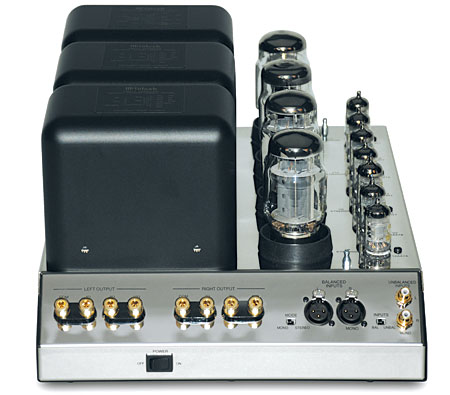| Columns Retired Columns & Blogs |
"Good audio engineering is timeless." —John Atkinson
Indeed!
Setup
I did all my listening through Revel's Ultima Studio2 speakers. The digital source was a Krell Evolution 505 SACD/CD player; for analog, I used VPI's Classic turntable and JMW Memorial tonearm, a Lyra Delos moving-coil cartridge, and a battery-powered Nagra BPS phono preamp. For a line stage, I used the preamp section of the Krell FBI, a fully balanced integrated amp. (The FBI is essentially Krell's FPB-300cx power amp and KCT preamp on a single chassis, internally connected by Krell's proprietary CAST circuitry.)

For a brief time, however, I disconnected the Krell and substituted the McIntosh C2300 tube preamp ($6000), also on loan from McIntosh. I did this for two reasons: first, to hear what the MC275 would sound like in an all-tube system, and especially when joined to a product made by the same company (Hinton told me that the two models are often sold together); and second, to use the MC275's balanced inputs. (The Krell FBI has just one pair of preamp-output jacks, and they're single-ended.)
Finally, I mainly used the MC275's 4-ohm taps, although, for comparison, I listened for a while with speaker cables hooked up to the 8-ohm taps (more on this below). Cables throughout were by Nirvana, except for Nordost CAST interconnects between the Krell SACD player and FBI. When I switched to the McIntosh C2300 preamp, I connected it to the Krell Evolution 505 with a pair of balanced Nirvanas.
Sound
So, did the McIntosh MC275 sound like a burnished antique, or like a 21st-century high-end audio component? I went into my listening expecting the former. Nothing wrong with that, I said to myself, working up an appetite for the sonic equivalent of a sweet crepe suzette or a creamy devil's-food cake. Imagine my surprise when I was presented with a five-course meal boasting the tastes and textures of all the major food groups.
Listening to Chasin' the Gypsy, saxophonist James Carter's tribute to Django Reinhardt (CD, Atlantic ATL 83304-2), I could hear all the attacks and rhythms of the bells, snappers, cymbal swishes, and guitar strums, as well as the difference between the guitar with steel strings and the one with strings of nylon. In the riveting live performance of Mahler's Symphony 9 by Michael Tilson Thomas and the San Francisco Symphony (SACD/CD, SFS 821936-0007-2), the horns were brassy, and the violins' bowing exuded the texture of resin. In Miles Davis' take on "My Funny Valentine," from Cookin' (SACD and 45rpm LP, Prestige/Analogue Productions CAPJ 7094 SA and 7094), the trumpet's bell was golden, the mouthpiece full of air. With Count Basie's 88 Basie Street (XRCD, JVC JVCXR-0021-2), I could clearly hear the blooming overtones sent up by Basie's one-note piano jabs; the sense of ambience in the recording hall was palpable.
Playing a vinyl reissue of Eric Dolphy's masterpiece, Out to Lunch (45rpm LP, Blue Note/Music Matters Jazz MMBST 81463), I could clearly hear—I could practically feel—the keypads of Dolphy's bass clarinet, and Tony Williams' work on snare and cymbals, with sticks or brushes, came through in all its dynamic detail. The very high frequencies on Dave Douglas's Charms of the Night Sky (CD, Winter & Winter 910 015-2) were a bit veiled, but I could still distinguish between Douglas's trumpet and Mark Feldman's violin when they played simultaneously—a testament to the MC275's ability to reproduce a coherent structure between tones and overtones. And when Lorraine Hunt Lieberson sang "Ich habe genug," from her Bach Cantatas album with Craig Smith and the Emmanuel Music Orchestra (CD, Nonesuch 79692-2), her voice soared so gorgeously, swelling in volume and bursting with pathos while remaining meltingly warm. The MC275 could rock, too. At the start of Radiohead's In Rainbows (CD, TBR 88088-21622-2), those crunches crunched crisply and loudly, Johnny Greenwood's guitar strums were tight and liquid, each piece of Phil Selway's drum kit was distinct, and Thom Yorke's voice beamed through the mix.
After spending the last several years with solid-state amps, I'd forgotten about the spacious soundstage a good tube amp can toss up. The MC275's soundstage wasn't anything special from left to right—though don't get me wrong, it was fine—but it was stunning from front to back. Those horns in Mahler's Ninth were way back there. And in all dimensions, the silences between the instruments, as well as between the notes each instrument plays, were spookily silent—as if I could still see the players, or the space they occupied, even when they weren't making any sounds.

"Good audio engineering is timeless." —John Atkinson
Indeed!